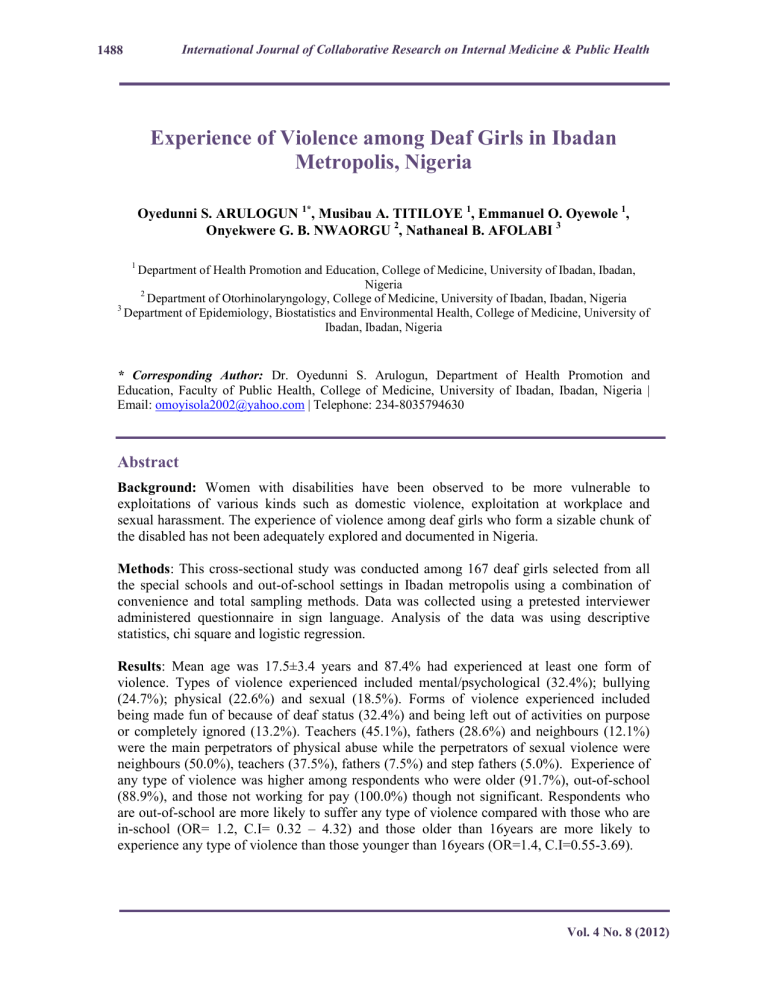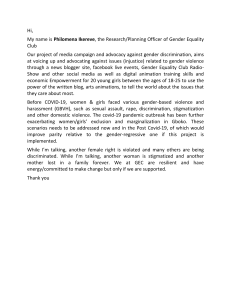Experience-of-violence-among-deaf-girls-in-ibadanmetropolis-nigeria
advertisement

International Journal of Collaborative Research on Internal Medicine & Public Health 1488 Experience of Violence among Deaf Girls in Ibadan Metropolis, Nigeria Oyedunni S. ARULOGUN 1*, Musibau A. TITILOYE 1, Emmanuel O. Oyewole 1, Onyekwere G. B. NWAORGU 2, Nathaneal B. AFOLABI 3 1 Department of Health Promotion and Education, College of Medicine, University of Ibadan, Ibadan, Nigeria 2 Department of Otorhinolaryngology, College of Medicine, University of Ibadan, Ibadan, Nigeria 3 Department of Epidemiology, Biostatistics and Environmental Health, College of Medicine, University of Ibadan, Ibadan, Nigeria * Corresponding Author: Dr. Oyedunni S. Arulogun, Department of Health Promotion and Education, Faculty of Public Health, College of Medicine, University of Ibadan, Ibadan, Nigeria | Email: omoyisola2002@yahoo.com | Telephone: 234-8035794630 Abstract Background: Women with disabilities have been observed to be more vulnerable to exploitations of various kinds such as domestic violence, exploitation at workplace and sexual harassment. The experience of violence among deaf girls who form a sizable chunk of the disabled has not been adequately explored and documented in Nigeria. Methods: This cross-sectional study was conducted among 167 deaf girls selected from all the special schools and out-of-school settings in Ibadan metropolis using a combination of convenience and total sampling methods. Data was collected using a pretested interviewer administered questionnaire in sign language. Analysis of the data was using descriptive statistics, chi square and logistic regression. Results: Mean age was 17.5±3.4 years and 87.4% had experienced at least one form of violence. Types of violence experienced included mental/psychological (32.4%); bullying (24.7%); physical (22.6%) and sexual (18.5%). Forms of violence experienced included being made fun of because of deaf status (32.4%) and being left out of activities on purpose or completely ignored (13.2%). Teachers (45.1%), fathers (28.6%) and neighbours (12.1%) were the main perpetrators of physical abuse while the perpetrators of sexual violence were neighbours (50.0%), teachers (37.5%), fathers (7.5%) and step fathers (5.0%). Experience of any type of violence was higher among respondents who were older (91.7%), out-of-school (88.9%), and those not working for pay (100.0%) though not significant. Respondents who are out-of-school are more likely to suffer any type of violence compared with those who are in-school (OR= 1.2, C.I= 0.32 – 4.32) and those older than 16years are more likely to experience any type of violence than those younger than 16years (OR=1.4, C.I=0.55-3.69). Vol. 4 No. 8 (2012) 1489 International Journal of Collaborative Research on Internal Medicine & Public Health Conclusion: There is therefore the need for sensitization and preventive interventions targeting deaf girls to ameliorate the situation. Keywords: deafness, girl, violence, prevalence Introduction Women with disabilities tend to be more vulnerable to exploitation of various kinds, such as sexual harassment, domestic violence and exploitation in the workplace1. Disabled women also tend to be relatively easy targets of sexual exploitation, tend to be in a state of physical, social and economic dependency. This can lead to increased vulnerability to exploitation and violence. It has also been reported that because of the relative isolation and anonymity in which women with disabilities live, the potential for physical and emotional abuse is high. It is estimated that having a disability doubles an individual's likelihood of being assaulted2. In Canada, the Disabled Women's Network of Canada3 surveyed 245 women with disabilities and found that 40% had experienced abuse; 12% had been raped. Perpetrators of the abuse were primarily spouses and ex-spouses (37%) and strangers (28%), followed by parents (15%), service providers (10%), and dates (7%). 7 Children with disabilities including deaf children have been found to be at greater risk for sexual abuse both at residential school and at home. One study of deaf and hearing children at a language institute found that 54% of the deaf boys reported abuse compared to 10% of hearing boys. Deaf girls reported 50% rates of abuse compared to 25% of hearing girls4. Childhood sexual abuse has been found to be a strong indication for risky sexual and substance use behaviour and HIV infection as an adult5. Data from an eight-year survey of college students at Rochester Institute of Technology indicates that deaf and hard-of-hearing individuals are 1.5 times more likely to be victims of relationship violence, including sexual harassment, sexual assault psychological abuse and physical abuse, in their lifetimes6. Furthermore, disabled women had been reportedly used as scapegoats or an outlet for relieving anger and irritation as most cases studied were beaten for no reason7. Almost half the women said they had been slapped, hit, kicked or beaten by their husbands at some time. 24% of the women reported having been kicked by their husbands at some point during their married life, and 44% were reportedly kicked during pregnancy. 12% were specifically threatened by their husbands with having kerosene oil poured on them to set them on fire. 30% of the physically assaulted victims required medical care. The prevalence of abuse among women in general has been fairly well documented, yet there are very few studies that have examined the prevalence among women with disabilities. In Nigeria, research exploring the prevalence and consequences of sexual assault among women with disabilities is generally limited as documented by Olubodun8. This study was therefore carried out to bridge this gap in knowledge. Vol. 4 No. 8 (2012) 1490 International Journal of Collaborative Research on Internal Medicine & Public Health Methodology Study Design The study adopted a descriptive cross sectional design that assessed types and prevalence of violence experienced by deaf girls in Ibadan metropolis. Setting and study population Ibadan in Oyo State Nigeria was purposively selected as the site for this study. The criterion for selecting this site was based on the fact that it is home to one of the earliest establishments for the deaf. Furthermore, the study target population who are the deaf, are concentrated in different clusters around Ibadan. These population clusters are around elementary and secondary schools as well as vocational and residential homes. The study population for the study consisted of deaf girls aged 11-24years who were either in or out-of-school as at the time of the study. Recruitment procedure The deaf population for participation in the study is defined as individuals whose hearing is sufficiently non-functional for ordinary life to compel them to use sign language as their primary language. Those who were excluded from the study included those whose level of hearing is sufficiently adequate such that they do not have sign language as their primary language; as well as those deaf persons with other co-morbidities including self-identified intellectual impairment or learning disabilities. All the deaf girls in all the special schools with provision for the deaf who met the inclusion criteria of being deaf and have sign language as their primary language were surveyed. The out-of-school deaf girls were accessed from their workplaces or home through snowball technique. Before the administration of the questionnaire, informed consent was obtained from the respondents after the objectives have been explained to them in sign language and they were requested to append their signature on the consent forms. Interpreters who were certified were recruited and trained as research assistants and subsequently administered the questionnaire on consenting deaf girls. Confidentiality was ensured as no identifiers were included in the questionnaire. Interviews were conducted in a place that ensured minimal distraction away from the visual distance of other people. The collected data were stored in a secured place. Instrument for data collection A structured questionnaire was used to collect information on respondents’ sociodemographic characteristics as well as on the types and prevalence of violence ever experienced. Questions included whether they had been bullied, beaten or physically maltreated, forced to have sex and who the perpetrators of these types of violence were. Validity and reliability of instrument To ensure validity of the instrument, a draft of the questionnaire was constructed by consulting relevant literature, subjected to reviews from other experts after which it was pretested in a community that is sufficiently far from Ibadan among deaf girls who share similar Vol. 4 No. 8 (2012) 1491 International Journal of Collaborative Research on Internal Medicine & Public Health characteristics with the study population. Certified interpreters who were trained as research assistants collected the data. Data analysis Each questionnaire was scrutinized for completeness, coded and entered into the computer. The SPSS Version 15 was used in analyzing the data. Descriptive, chi-square statistics and logistic regression were used for data analysis. All statistical tests were carried out at 5% (or 0.05) level of significance. Ethical Considerations This study followed the ethical principles guiding the use of human participants in research. Approval for the study was obtained from the University of Ibadan/ University College Hospital Health Research Ethics Committee (Ref No. UI/EC/08/0019). The vulnerability of the deaf girls was acknowledged and the potential benefit to the local community of our research was emphasized. Prior to surveying the participants, permission to carry out the study was obtained from relevant local school authorities concerned and the bosses of the out-of-school participants. The nature, purpose and process of the study were explained to the participants after which written informed consent were obtained. Participants were assured of confidentiality, privacy and anonymity of information provided. It was explained to the participants using sign language that the confidentiality of information shared during the interview would be guaranteed. Necessary steps such as asking for no names and keeping data sources in a secure place were taken to ensure confidentiality. Participants were continuously reminded of their right to withdraw from the study at any time. Participants were reassured that refusing to participate in or withdrawing from the study would not disadvantage them in any way. Results Socio-demographic characteristics A total of 167 deaf girls comprising 140(83.8%) in-school and 27 (16.2%) out-of-school were interviewed. More of the respondents (47.3%) were in the 16-20 age group with an overall mean age of 17.5±3.4 years as at their last birthday. One hundred and fifty-one (90.4%) respondents had ever attended a deaf school and 82.8% were in-school as at the time of data collection. Of those who had attended school, 87.8% attended mixed schools and only 12.2% went to girls only schools. In addition to schooling 26.3% of respondents (68.2% in-school and 31.8% out-of-school) had ever worked for pay. Only 14.4% of respondents (45.8% inschool and 54.2% out-of-school) were working for pay at the time of the study. Types and prevalence of violence Table 2 presents the types and prevalence of violence experienced by respondents. Majority of the respondents 146(87.4%) had reportedly ever experienced one form of violence or the other. Types of violence experienced were mental/psychological (34.2%); bullying (24.7%); physical (22.6%) and sexual (18.5%). Vol. 4 No. 8 (2012) 1492 International Journal of Collaborative Research on Internal Medicine & Public Health Forms of bullying experienced included being made fun of because of deaf status (32.4%), being made fun of because of the way her face or body looked (26.5%), being left out of activities on purpose or completely ignored (13.2%), being made fun of with sexual jokes, comments or gestures (13.2%) and being hit, pushed or locked indoor (14.7%). Of the 91 who were physically abused, teachers (45.1%), fathers (28.6%) and neighbours (12.1%) were the main perpetrators. The perpetrators of sexual violence among respondents who reported experiencing sexual violence were neighbours (50.0%), teachers (37.5%), fathers (7.5%) and step fathers (5.0%). Experience of any type of violence was higher among respondents who were older (91.7%), out-of-school (88.9%), those who had primary education (90.0%) and those not working for pay (100.0%) but these differences were not statistically significant (Table 3). Those out-ofschool were 1.2 times more likely to suffer any type of violence compared with those who are in-school (OR= 1.2, C.I= 0.32 – 4.32). Also, age was found to be a predisposing factor for violence as respondents who are older than 21years were 1.4 times more likely to experience any type of violence than those younger than 21years (OR=1.4, C.I=0.55-3.69) (Table 4) Discussion The study documented an 87.4% prevalence of violence among the study population, a prevalence higher than those documented among hearing populations9,10. This finding corroborates the assertion of International Leadership for Women with Disabilities11 which documented that sexual violence against disabled girls and women occurs at alarming rates within families, in institutions, and throughout society; 12.6% of the physically disabled respondents studied reported having been raped and 15% confessed to being pinched and uncomfortable touching. The finding that the perpetrators of the types of violence experienced were known persons has also been documented elsewhere11 that frequently the abuser or perpetrator of violence among the disabled girls is trusted by the family or a caretaker on whom the girl is dependent. Sobsey and Doe12 also corroborates this in their findings where in 96% of the cases, the perpetrator was known to the victim and 44% of the perpetrators were service providers. Education was found to be protective of violence. This finding is important as it has implications for the education of the deaf girl child. Parents, guardians and all stakeholders are to encourage and advocate for the education of deaf girls. Educating the girls would expectedly build their self esteem, assertiveness and ability to protect self from violence. Presence of violence among this group highlights an unmet reproductive health and right need, an area that future research can further explore. It therefore imperative to advocate for the promotion of deaf girls’ health and right as well as the development and implementation of appropriate and deaf culture sensitive intervention programs to ameliorate the situation. Conclusion Vol. 4 No. 8 (2012) 1493 International Journal of Collaborative Research on Internal Medicine & Public Health The study documented a high prevalence of violence among the deaf girls studied. It buttresses the fact that violence against disabled girls and women is a major problem and statistics show that disabled girls and women are more likely to be victims of violence because of their vulnerability. The disabled girl and woman’s protection against violence need to be guaranteed while recognizing their right to be free from violence. There is the need for effective interventions specific to nature of disability among this group of girls. Competing interest The authors declare that they have no competing interest Authors’ contributions All authors have contributed to this study in ways consistent with ICJME authorship criteria. All the authors have read and approved the final version of this manuscript Acknowledgements This research received financial support from UNDP/UNFPA/WHO/WORLD BANK Special programme of Research, Development and Research training in Human Reproduction Grant ID A65459. We want to thank all respondents who participated in the study. We are grateful to the authorities of all the schools and the bosses of the out-of-school deaf girls who provided official approval for this study. References 1. UNDP. Human Development Report. Gender and Human Development. Geneva. Available at http://hdr.undp.org/en/reports/global/hdr1995/chapters/ Accessed on February 28, 2012. 2. Dreiedger D. In: Driedger D, Feika I, Gironbatres E, eds. Emerging from the Shadows: Women with Disabilities Organise. . Across Borders. Charlotte Town, Canada: Gynergy Books. 3. Ridington, J. Beating the ‘odds’: Violence and women with disabilities (Position Paper 2). 1989. Vancouver: DisAbled Women's Network: Canada. 4. Sullivan PM, Vernon M and Scanlan JH. Sexual abuse of deaf youth. Am Ann Deaf 1987;132:256-262. Vol. 4 No. 8 (2012) 1494 International Journal of Collaborative Research on Internal Medicine & Public Health 5. Whitmire JL and Harrow L.Childhood sexual abuse linked with adult substance use, victimization and AIDS-risk. AIDS EducPrev 1996;80: 44-57. 6. Dube W.College Survey Indicates Relationship Violence is Higher in the Deaf Community. Available at http://www.rit.edu/news/story.php?id. Accessed February 28, 2012. 7. Jain D, Sanon S, Sadowski L,Hunter W.Violence against women in India: evidence from rural Maharashtra. Rural and Remote Health 4 (online), 2004: no 304, 8 pages. Available at www.rrh.org.au/publishedarticles/article_print_304_pdf. Fulltext. Accessed February 28, 2012. 8. Olubodun WO. The life experiences of deaf high school graduates in Nigeria. (2003) (January 1, 2003). ETD collection for University of Nebraska - Lincoln. Paper AAI3092582. Available at: http://digitalcommons.unl.edu/dissertations/AAI3092582 9. Arulogun OS and Jidda KA. Experiences of Violence among Pregnant Women Attending Ante Natal Clinics in Selected Hospitals in Abuja, Nigeria. Sierra Leone J Biomed Res 2011; 3(1): 43-48. 10. Fawole OI, Ajuwon JA, Osungbade KO, Faweya OC.Prevalence and nature of violence among young female hawkers in motor-parks in south-western Nigeria. Health Educ 2002;102(5): 230-238. 11. International Leadership for Women with Disabilities: Fact Sheet on Women & Disability 1995. Prepared by Rehabilitation International, 25 East 21 Street, New York, NY 10010 USA. 12. Sobsey, D. Doe, T. Patterns of sexual abuse and assault. Sex Disabily, 1991; 9(3), 243-260. Vol. 4 No. 8 (2012) 1495 International Journal of Collaborative Research on Internal Medicine & Public Health Table 1: Socio-demographic characteristics of respondents Socio-demographic characteristics Frequency Percentage % Age in years 11-15 16-20 21 and above 52 79 36 31.1 47.3 21.6 Total 167 100.0 Schooling status In-School Out-Of School Total 140 27 167 83.8 16.2 100.0 44 123 167 26.3 73.7 100.0 Currently working Yes No Total Table 2: Experience of violence among respondents Ever experienced violence (N=167) Frequency Percentage % Yes 146 87.4 No 21 12.6 Sexual 27 18.5 Physical 33 22.6 Bully 36 24.7 Mental/Psychological 50 34.2 Types of violence reportedly experienced (N=146) Vol. 4 No. 8 (2012) 1496 International Journal of Collaborative Research on Internal Medicine & Public Health Table 3: Association between Experience of any form of Violence and demographic Variables Demographic Variables Age Group <21 Years >21 Years Status In School Out of School Religion None Muslim Christianity Currently working for pay Yes No Experienced Any form of Violence Yes (%) No (%) P-Value 113 (77.4) 33 (22.6) 18 (85.7) 3 (14.3) 0.386 122 (83.6) 24(16.4 18(85.7) 3 (14.3) 0.802 4 (2.7) 49 (33.6) 93(63.7) 1 (4.8) 4 (19.0) 16(76.2) 22 (51.2) 1(100.0) 21 (48.8) 0 (0.0) 0.385 0.334 Table 4: Odds ratio of independent factors affecting experience of violence Variable Age <16years >16years (Ref <16 years) School attendance In-school Out-of-school (Ref in-school) Odds Ratio 1.4 1.2 95% CI OR P-value 0.94-9.89 0.463 0.32-4.32 0.802 Vol. 4 No. 8 (2012)



